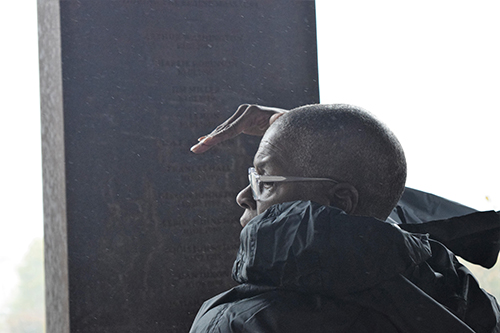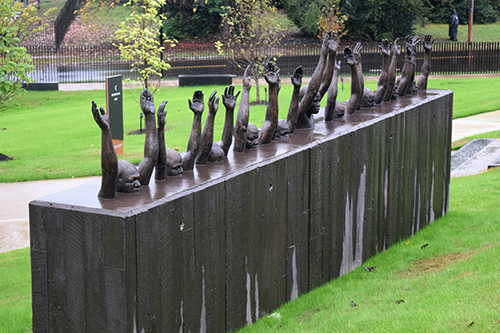
Pam Adams studies inscriptions at the National Memorial for Peace and Justice. (PHOTO BY JILL FRIEDMAN FOR COMMUNITY WORD)
BY PAM ADAMS
“At the site where you are standing, enslaved people were imprisoned with livestock, horses, pigs and cattle.”
This is the Legacy Museum: From Enslavement to Mass Incarceration. The museum site shares a trendy, brick-paved alleyway of bars and restaurants just off Commerce Street, a main drag in downtown Montgomery.
In front of the Equal Justice Initiative, the human rights law firm located along Commerce between the Hank Williams Museum and a Jimmy Johns, is a marker that points out just what the major commerce was during the early part of Montgomery’s history.
The museum, opened in April by the EJI in the former slave warehouse adjoining its office, also highlights the business of slavery.
Montgomery is a city shaped by slavery and the legacy of this horrific era is all around you.
The legacy was supposed to be confined to the exhibits. But there he was, Kuntrell Jackson, a real-life legacy of enslavement-to-mass incarceration.
He was standing a few steps from an interactive video simulation of a prison visit. Pick up the telephone, view and hear former inmates, all EJI clients and breathe in the personal voices recounting the politics of mass incarceration.
Jackson’s video is featured in the exhibit along with four others. Anthony Ray Hinton, for example, spent 30 years on Alabama’s death row for a crime he didn’t commit. At 17, Robert Caston was sentenced to die in a Louisiana prison. He served more than 45 years before EJI won a landmark U.S. Supreme Court case declaring juvenile mandatory life-without-parole sentences unconstitutional. The decision paved the way for almost 3,000 resentencing hearings across the country, including in Illinois. Caston was released in 2012 at age 64.
“We went straight to picking cotton, cutting sugar cane or whatever it took in the fields,” Caston says in the video, referring to his first days at the notorious Louisiana prison known as Angola.
But Caston, Hinton and the others were video images. Jackson was there, in the flesh, watching us as we watched him in the video.
Like Caston, he won a new sentencing hearing after the Supreme Court ruling on harsh juvenile sentences. Imprisoned in Arkansas at the age of 14, he had served 17 years by the time he was paroled in 2017.
Jackson would have been easy to mistake as just another face in the crowd. But somehow he had gotten into a discussion with a group from Virginia.
He works and takes classes, he told the group, and he visits the museum everyday.
Asked why, he said, “To meet people like you.”
The answer led a therapist in the group to ask if he had received counseling. He made it clear he was not a fan of counselors or counseling.
“You all are my therapists,” he said. “I stand right here and watch you watching me. That helps me more than anything. I see people being so sincere about my pain and struggle and they don’t even know me. You didn’t even know I was here.”
The exchange between Jackson and the therapist had a tense edge. The tension dissolved when another girl in the group stepped forward. Jackson braced himself for her question.
“I just want a hug,” she said. “My brother’s been in solitary confinement and I haven’t talked to him for a month.”
The museum is a visual history, a tormenting horde of words and images under 11,000 square feet:
Holograms of actors, using words directly from slave narratives, evoke the pain and trauma of slavery; blown-up banners of catalogues of the sale of human property, (“they have been absolutely controlled but never abused”); exact wording of state and local laws enforcing everything from separate playgrounds for amateur baseball games to separate carnival ticket booths for white and Black; town signs boasting whites-only policies; Civil Rights Movement backlash, followed by details on the impact of the drug war (Between Nixon’s law-and-order crusade and the war on drugs, incarceration escalated from 300,000 to 2.3 million, starting in 1971).
Wall-to-floor banners line one side:
Kidnapped? 12 million during the transatlantic slave trade
Terrorized by threat of racial violence? 9 million.
Segregated? 10 million.
African-American citizens incarcerated? 8 million Americans under criminal control
And this quote, easily missed among the displays, videos and interactive exhibits:
“The criminal justice system remains the institution in American life least impacted by the Civil Rights Movement.”

Hank Willis Thomas’ sculpture “Raise Up” evokes links between lynching and contemporary issues of police brutality such as the rallying cry of Black Lives Matter “Hands Up, Don’t Shoot.” (PHOTO BY JILL FRIEDMAN FOR COMMUNITY WORD)
